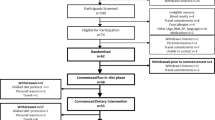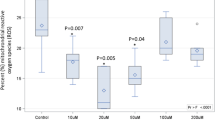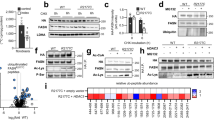Abstract
Background/Objectives:
Omega-3 polyunsaturated fatty acids (n-3PUFA) are better absorbed when they are combined with high-fat meals. However, the role of different dietary fats in modulating the incorporation of n-3PUFA in blood lipids in humans has not been previously explored. Omega-6 polyunsaturated fatty acids (n-6PUFA) are known to compete with n-3PUFA in the metabolic pathways and for the incorporation into phospholipids, whereas saturated fats (SFA) may enhance n-3PUFA incorporation into tissues.
Subjects/Methods:
In a randomized parallel-design trial, we aimed to investigate the long-term effects of n-3PUFA supplementation in subjects consuming a diet enriched with either SFA or n-6PUFA on fatty acid incorporation into plasma and erythrocytes and on blood lipid profiles (total cholesterol, low-density lipoprotein cholesterol (LDL-C), high-density lipoprotein cholesterol (HDL-C) and triglycerides).
Results:
Dietary supplementation with n-3PUFA co-administered with SFA for 6 weeks resulted in a significant rise in total cholesterol (0.46±0.60 mmol/L; P=0.020) and LDL-C (0.48±0.48 mmol/L; P=0.011) in comparison with combination with n-6PUFA. The diet enriched with SFA also induced a greater increase in eicosapentaenoic acid (2.07±0.79 vs 1.15±0.53; P=0.004), a smaller decrease in docosapentaenoic acid (−0.12±0.23 vs −0.30±0.20; P=0.034) and a similar increase in docosahexaenoic acid (3.85±1.14 vs 3.10±1.07; P=0.128) percentage in plasma compared with the diet enriched with n-6PUFA. A similar effect was seen in erythrocytes. N-3PUFA supplementation resulted in similar changes in HDL-C and triglyceride levels.
Conclusions:
The results suggest that dietary substitution of SFA with n-6PUFA, despite maintaining low levels of circulating cholesterol, hinders n-3PUFA incorporation into plasma and tissue lipids.
This is a preview of subscription content, access via your institution
Access options
Subscribe to this journal
Receive 12 print issues and online access
$259.00 per year
only $21.58 per issue
Buy this article
- Purchase on Springer Link
- Instant access to full article PDF
Prices may be subject to local taxes which are calculated during checkout
Similar content being viewed by others
References
Kromhout D, Menotti A, Bloemberg B, Aravanis C, Blackburn R, Buzina R et al. Dietary saturated and trans fatty acids and cholesterol and 25-year mortality from coronary heart disease: The Seven Countries Study. Prev Med. 1995; 24: 308–315.
Yamagishi K, Nettleton JA, Folsom AR . Plasma fatty acid composition and incident heart failure in middle-aged adults: The Atherosclerosis Risk in Communities (ARIC) Study. Am Heart J 2008; 156: 965–974.
de Souza RJ, Mente A, Maroleanu A, Cozma AI, Ha V, Kishibe T et al. Intake of saturated and trans unsaturated fatty acids and risk of all cause mortality, cardiovascular disease, and type 2 diabetes: systematic review and meta-analysis of observational studies. BMJ 2015; 02: 04.
Mozaffarian D, Micha R, Wallace S . Effects on coronary heart disease of increasing polyunsaturated fat in place of saturated fat: a systematic review and meta-analysis of randomized controlled trials. PLoS Med 2010; 7: e1000252.
Siri-Tarino PW, Sun Q, Hu FB, Krauss RM . Meta-analysis of prospective cohort studies evaluating the association of saturated fat with cardiovascular disease. Am J Clin Nutr 2010; 91: 535–546.
Shekelle RB, Shryock AM, Paul O, Lepper M, Stamler J, Liu S et al. Diet, serum cholesterol, and death from coronary heart disease. N Engl J Med 1981; 304: 65–70.
Mirmiran P, Ramezankhani A, Azizi F . Combined effects of saturated fat and cholesterol intakes on serum lipids: Tehran Lipid and Glucose Study. Nutrition 2009; 25: 526–531.
Samuelson G, Bratteby L, Mohsen R, Vessby B . Dietary fat intake in healthy adolescents: inverse relationships between the estimated intake of saturated fatty acids and serum cholesterol. Br J Nutr 2001; 85: 333–341.
Otto MCdO, Nettleton JA, Lemaitre RN, Steffen LM, Kromhout D, Rich SS et al. Biomarkers of dairy fatty acids and risk of cardiovascular disease in the multi‐ethnic study of atherosclerosis. J Am Heart Assoc 2013; 2: e000092.
Sjogren P, Rosell M, Skoglund-Andersson C, Zdravkovic S, Vessby B, de Faire U et al. Milk-derived fatty acids are associated with a more favorable LDL particle size distribution in healthy men. J Nutr 2004; 134: 1729–1735.
Soedamah-Muthu SS, Masset G, Verberne L, Geleijnse JM, Brunner EJ . Consumption of dairy products and associations with incident diabetes, CHD and mortality in the Whitehall II study. Br J Nutr 2013; 109: 718–726.
Garg ML, Thomson ABR, Clandinin MT . Interactions of saturated, n-6 and n-3 polyunsaturated fatty acids to modulate arachidonic acid metabolism. J Lipid Res 1990; 31: 271–277.
MacDonald-Wicks LK, Garg ML . Incorporation of n-3 Fatty Acids into Plasma and Liver Lipids of Rats: Importance of Background Dietary Fat. Lipids 2004; 39: 545–551.
Keys A, Anderson JT, Grande F . Prediction of serum-cholesterol responses of man to changes in fats in the diet. Lancet 1957; 273: 959–966.
Ahrens EH, Insull W, Blomstrand R, Hirsch J, Tsaltas T, Peterson M . The influence of dietary fats on serum lipid levels in man. Lancet 1957; 1: 944–953.
Shepherd J, Packard CJ, Grundy SM, Yeshurun D, Gotto J, Antonio M. et al. Effects of saturated and polyunsaturated fat diets on the chemical composition and metabolism of low density lipoproteins in man. J Lipid Res 1980; 21: 91–99.
Ramsden CE, Zamora D, Leelarthaepin B, Majchrzak-Hong SF, Faurot KR, Suchindran CM et al. Use of dietary linoleic acid for secondary prevention of coronary heart disease and death: evaluation of recovered data from the Sydney Diet Heart Study and updated meta-analysis. BMJ 2013; 346.
Liou YA, Innis SM . Dietary linoleic acid has no effect on arachidonic acid, but increases n-6 eicosadienoic acid, and lowers dihomo-γ-linolenic and eicosapentaenoic acid in plasma of adult men. Prostaglandins Leukotrienes Essent Fatty Acids 2009; 80: 201–206.
Novak EM, Dyer RA, Innis SM . High dietary ω-6 fatty acids contribute to reduced docosahexaenoic acid in the developing brain and inhibit secondary neurite growth. Brain Res 2008; 1237: 136–145.
Russo GL . Dietary n-6 and n-3 polyunsaturated fatty acids: from biochemistry to clinical implications in cardiovascular prevention. Biochem Pharmacol 2009; 77: 937–946.
Stubbs CD, Smith AD . The modification of mammalian membrane polyunsaturated fatty acid composition in relation to membrane fluidity and function. Biochim Biophys Acta 1984; 779: 89–137.
Eslick GD, Howe PRC, Smith C, Priest R, Bensoussan A . Benefits of fish oil supplementation in hyperlipidemia: a systematic review and meta-analysis. Int J Cardiol 2009; 136: 4–16.
Dawczynski C, Massey KA, Ness C, Kiehntopf M, Stepanow S, Platzer M et al. Randomized placebo-controlled intervention with n-3 LC-PUFA supplemented yoghurt: Effects on circulating eicosanoids and cardiovascular risk factors. Clin Nutr 2013; 32: 686–696.
Lepage G, Roy GC . Direct trans-esterification of all classes of lipid in an onestep reaction. J Lip Res 1986; 27: 114–120.
Wood LG, Fitzgerald DA, Gibson PG, Cooper DM, Garg ML . Increased plasma fatty acid concentrations after respiratory exacerbations are associated with elevated oxidative stress in cystic fibrosis patients. Am J Clin Nutr 2002; 75: 668–675.
Micallef MA, Garg ML . The lipid-lowering effects of phytosterols and (n-3) polyunsaturated fatty acids are synergistic and complementary in hyperlipidemic men and women. J Nutr 2008; 138: 1086–1090.
Garg ML, Wierzbicki AA, Thomson ABR, Clandinin MT . Dietary saturated fat level alters the competition between α-linolenic and linoleic acid. Lipids 1989; 24: 334–339.
Mori TA, Vandongen R, Beilin LJ, Burke V, Morris J, Ritchie J . Effects of varying dietary fat, fish, and fish oils on blood lipids in a randomized controlled trial in men at risk of heart disease. Am J Clin Nutr 1994; 59: 1060–1068.
Rivellese AA, Maffettone A, Vessby B, Uusitupa M, Hermansen K, Berglund L et al. Effects of dietary saturated, monounsaturated and n-3 fatty acids on fasting lipoproteins, LDL size and post-prandial lipid metabolism in healthy subjects. Atherosclerosis 2003; 167: 149–158.
Fernandez ML, West KL . Mechanisms by which dietary fatty acids modulate plasma lipids. J Nutr 2005; 135: 2075–2078.
Musa-Veloso K, Binns MA, Kocenas AC, Poon T, Elliot JA, Rice H et al. Long-chain omega-3 fatty acids eicosapentaenoic acid and docosahexaenoic acid dose-dependently reduce fasting serum triglycerides. Nutr Rev 2010; 68: 155–167.
Milte CM, Coates AM, Buckley JD, Hill AM, Howe PRC . Dose-dependent effects of docosahexaenoic acid-rich fish oil on erythrocyte docosahexaenoic acid and blood lipid levels. Br J Nutr 2008; 99: 1083–1088.
Mori TA, Burke V, Puddey IB, Watts GF, O’Neal DN, Best JD et al. Purified eicosapentaenoic and docosahexaenoic acids have differential effects on serum lipids and lipoproteins, LDL particle size, glucose, and insulin in mildly hyperlipidemic men. Am J Clin Nutr 2000; 71: 1085–1094.
Mustad VA, Ellsworth JL, Cooper AD, Kris-Etherton PM, Etherto TD . Dietary linoleic acid increases and palmitic acid decreases hepatic LDL receptor protein and mRNA abundance in young pigs. J Lipid Res 1996; 37: 2310–2323.
Wilkinson J, Higgins JA, Fitzsimmons C, Bowyer DE . Dietary fish oils modify the assembly of VLDL and expression of the LDL receptor in rabbit liver. Arterioscler Thromb Vasc Biol 1998; 18: 1490–1497.
Ishida T, Ohta M, Nakakuki M, Kami H, Uchiyama R, Kawano H et al. Distinct regulation of plasma LDL cholesterol by eicosapentaenoic acid and docosahexaenoic acid in high fat diet-fed hamsters: participation of cholesterol ester transfer protein and LDL receptor. Prostaglandins Leukotrienes Essent Fatty Acids 2013; 88: 281–288.
Griffin BA . The effect of n−3 fatty acids on low density lipoprotein subfractions. Lipids 2001; 36: S91–S97.
Jackson KG, Maitin V, Leake DS, Yaqoob P, Williams CM . Saturated fat-induced changes in Sf 60–400 particle composition reduces uptake of LDL by HepG2 cells. J Lipid Res 2006; 47: 393–403.
Olano-Martin E, Anil E, Caslake MJ, Packard CJ, Bedford D, Stewart G et al. Contribution of apolipoprotein E genotype and docosahexaenoic acid to the LDL-cholesterol response to fish oil. Atherosclerosis 2010; 209: 104–110.
Lee MW, Park JK, Hong JW, Kim KJ, Shin DY, Ahn CW et al. Beneficial effects of Omega-3 fatty acids on low density lipoprotein particle size in patients with type 2 diabetes already under Statin Therapy. Diabetes Metab J 2013; 37: 207–211.
Hirayama S, Miida T . Small dense LDL: an emerging risk factor for cardiovascular disease. Clin Chim Acta 2012; 414: 215–224.
Mora S, Szklo M, Otvos JD, Greenland P, Psaty BM, Goff DC Jr et al. LDL particle subclasses, LDL particle size, and carotid atherosclerosis in the Multi-Ethnic Study of Atherosclerosis (MESA). Atherosclerosis 2007; 192: 211–217.
Bergeron N, Havel RJ . Influence of diets rich in saturated and Omega-6 polyunsaturated fatty acids on the postprandial responses of apolipoproteins B-48, B-100, E, and lipids in triglyceride-rich lipoproteins. Arterioscler Thromb Vasc Biol 1995; 15: 2111–2121.
Bjermo H, Iggman D, Kullberg J, Dahlman I, Johansson L, Persson L et al. Effects of n−6 PUFAs compared with SFAs on liver fat, lipoproteins, and inflammation in abdominal obesity: a randomized controlled trial. Am J Clin Nutr 2012; 95: 1003–1012.
Dias CB, Garg R, Wood LG, Garg ML . Saturated fat consumption may not be the main cause of increased blood lipid levels. Med Hypotheses 2014; 82: 187–195.
Acknowledgements
This study was supported by a research grant from the Hunter Medical Research Institute. We are grateful to EPAX Norway AS (Norway) for providing the fish oil concentrate capsules; Ms Melissa Fry for assistance with the fatty acid analysis; and the volunteers from the Hunter Medical Research Institute (HMRI) research register. CBD was supported by a scholarship from Coordenação Nacional de Desenvolvimento Científico e Tecnológico-CNPq.
Author information
Authors and Affiliations
Corresponding author
Ethics declarations
Competing interests
The authors declare no conflict of interest.
Rights and permissions
About this article
Cite this article
Dias, C., Wood, L. & Garg, M. Effects of dietary saturated and n-6 polyunsaturated fatty acids on the incorporation of long-chain n-3 polyunsaturated fatty acids into blood lipids. Eur J Clin Nutr 70, 812–818 (2016). https://doi.org/10.1038/ejcn.2015.213
Received:
Revised:
Accepted:
Published:
Issue Date:
DOI: https://doi.org/10.1038/ejcn.2015.213
This article is cited by
-
Recent insights into dietary ω-6 fatty acid health implications using a systematic review
Food Science and Biotechnology (2022)
-
Krill oil extract suppresses the proliferation of colorectal cancer cells through activation of caspase 3/9
Nutrition & Metabolism (2019)
-
Association of the SPTLC3 rs364585 polymorphism and serum lipid profiles in two Chinese ethnic groups
Lipids in Health and Disease (2017)
-
Effect of diets rich in either saturated fat or n-6 polyunsaturated fatty acids and supplemented with long-chain n-3 polyunsaturated fatty acids on plasma lipoprotein profiles
European Journal of Clinical Nutrition (2017)



